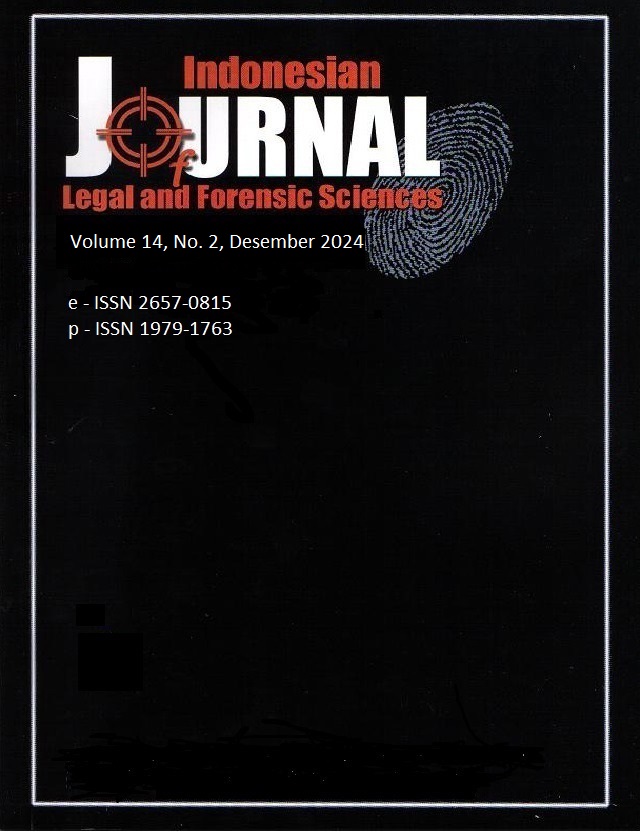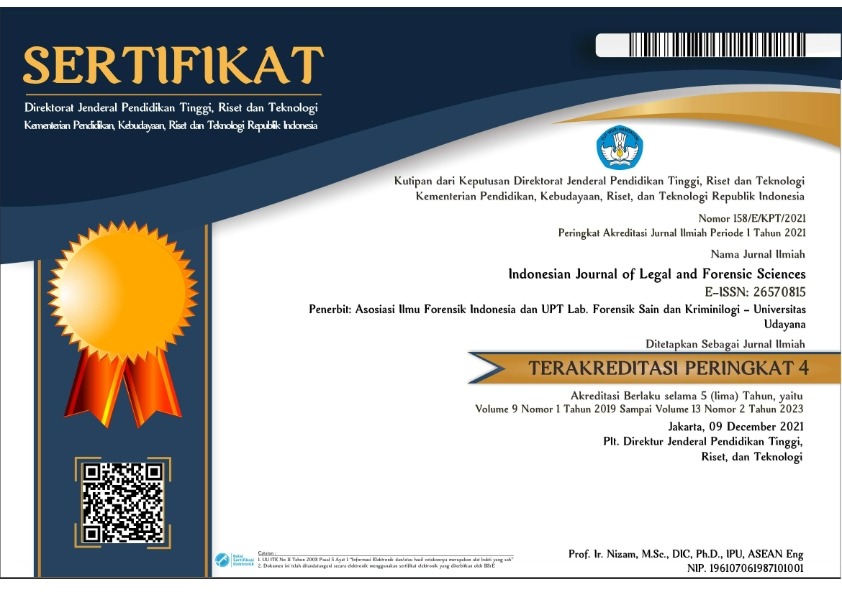Perkembangan Teknologi Digital dalam Kedokteran Gigi Forensik
Abstract
In this modern era, technology continues to grow rapidly and has become part of our everyday life. Recent advances have popularized various digital technologies for their use in forensic dentistry, especially to assist individuals. Various digital recovery methods have been included including replacing conventional forensic methods in terms of acquisition, analysis, efficiency, and accuracy. This review aims to discuss the development of digital technology within the scope of forensic dentistry as well as various methods through digital technology that can be used in solving various forensic cases. The writing of this review was carried out through a literature review on various databases in the form of PubMed, SciELO, MEDLINE, and Scholar within the last 10 years. Various digital developments in forensic dentistry that have been published include radiography and digital photography, reconstructing fragments with 3D Printing, Intra Oral 3D Scanners, UV photography in aid of dental materials, superimposed methods, assisted digital prostheses, virdentopsy & teledentistry, as well as various device developments software and database. Of these various methods, almost all methods produce good accuracy, simpler methods without any destructive action on forensic evidence, and save time compared to conventional methods. However, no method has been universally applied worldwide. This is due to limitations in accessing tools and costs that are not relatively cheap. In the future, digital technology will play a crucial role in forensics especially if it can be accessed easily.
Downloads
References
[2] R. Nagi, K. Aravinda, N. Rakesh, S. Jain, N. Kaur, and A. Mann, ‘Digitization in forensic odontology: A paradigm shift in forensic investigations’, J Forensic Dent Sci, vol. 11, no. 1, p. 5, 2019, doi: 10.4103/jfo.jfds_55_19.
[3] Badan Nasional Penanggulangan Bencana. Data Informasi Bencana Indonesia, 2020 [Internet]. Available from: https://dibi.bnpb.go.id/
[4] S. Matsuda, H. Yoshida, K. Ebata, I. Shimada, and H. Yoshimura, ‘Forensic odontology with digital technologies: A systematic review’, Journal of Forensic and Legal Medicine, vol. 74. Churchill Livingstone, Aug. 01, 2020. doi: 10.1016/j.jflm.2020.102004.
[5] P. Anuja and N. Doggalli, ‘Software in forensic odontology :P Anuja, Nagabhushana Doggalli, Indian Journal of Multidisciplinary Dentistry Anuja P, Doggalli N. Software in forensic odontology’, 2018. [Online]. Available: www.ijmdent.com/printarticle.asp?issn=2229-6360;year=2018;volume=8;issue=2;spage=94;epage=100;aulast=Anuja
[6] P. Schuller-Götzburg and J. Suchanek, ‘Forensic odontologists successfully identify tsunami victims in Phuket, Thailand’, Forensic Sci Int, vol. 171, no. 2–3, pp. 204–207, Sep. 2007, doi: 10.1016/j.forsciint.2006.08.013.
[7] M. Iino and Y. Aoki, ‘The use of radiology in the Japanese tsunami DVI process’, Journal of Forensic Radiology and Imaging, vol. 4, pp. 20–26, Mar. 2016, doi: 10.1016/j.jofri.2015.12.006.
[8] R. Lain, C. Griffiths, and J. M. N. Hilton, ‘Forensic dental and medical response to the Bali Bombing: A personal perspective’, Medical Journal of Australia, vol. 179, no. 7. Australasian Medical Publishing Co. Ltd, pp. 362–365, Oct. 06, 2003. doi: 10.5694/j.1326-5377.2003.tb05594.x.
[9] D. Errickson et al., ‘A survey of case studies on the use of forensic three-dimensional printing in England and Wales’, Int J Legal Med, vol. 136, no. 6, pp. 1605–1619, Nov. 2022, doi: 10.1007/s00414-022-02872-4.
[10] N. Giraudeau et al., ‘Teledentistry and forensic odontology: Cross-sectional observational comparative pilot study’, Forensic Sci Int, vol. 326, Sep. 2021, doi: 10.1016/j.forsciint.2021.110932.
[11] ‘A note on digital dental radiography in forensic odontology’, doi: 10.4103/0975-1475.137072.
[12] M. Yazdanian et al., ‘Dental Radiographic/Digital Radiography Technology along with Biological Agents in Human Identification’, Scanning, vol. 2022. Hindawi Limited, 2022. doi: 10.1155/2022/5265912.
[13] V. S. Amberkar, ‘Photography in Forensic Dentistry’, Indian Journal of Forensic Odontology, vol. 13, doi: 10.21088/ijfo.0974.505X.13120.2.
[14] Q. nan Mou et al., ‘Three-dimensional superimposition of digital models for individual identification’, Forensic Sci Int, vol. 318, Jan. 2021, doi: 10.1016/j.forsciint.2020.110597.
[15] D. De Angelis, C. Cattaneo, and M. Grandi, ‘Dental superimposition: A pilot study for standardising the method’, Int J Legal Med, vol. 121, no. 6, pp. 501–506, Nov. 2007, doi: 10.1007/s00414-007-0198-y.
[16] G. V. Reesu, S. Mânica, G. F. Revie, N. L. Brown, and P. A. Mossey, ‘Forensic dental identification using two-dimensional photographs of a smile and three-dimensional dental models: A 2D-3D superimposition method’, Forensic Sci Int, vol. 313, Aug. 2020, doi: 10.1016/j.forsciint.2020.110361.
[17] L. Robinson, C. Smit, and H. Bernitz, ‘Dental radiographic superimposition: An exciting addition to the forensic odontology armamentarium’, Forensic Imaging, vol. 30, Sep. 2022, doi: 10.1016/j.fri.2022.200513.
[18] Q. nan Mou et al., ‘Three-dimensional superimposition of digital models for individual identification’, Forensic Sci Int, vol. 318, Jan. 2021, doi: 10.1016/j.forsciint.2020.110597.
[19] G. Jani, A. Johnson, U. Parekh, T. Thompson, and A. Pandey, ‘Effective approaches to three-dimensional digital reconstruction of fragmented human skeletal remains using laser surface scanning’, Forensic Sci Int, vol. 2, pp. 215–223, Jan. 2020, doi: 10.1016/j.fsisyn.2020.07.002.
[20] G. Fournier, F. Savall, A. Galibourg, L. Gély, N. Telmon, and D. Maret, ‘Three-dimensional analysis of bitemarks: A validation study using an intraoral scanner’, Forensic Sci Int, vol. 309, Apr. 2020, doi: 10.1016/j.forsciint.2020.110198.
[21] H. Utomo, M. S. M. A. Ruth, L. G. Wangsa, R. E. Salazar-Gamarra, and L. L. Dib, ‘Simple smartphone applications for superimposing 3D imagery in forensic dentistry’, Dental Journal, vol. 53, no. 1. Universitas Airlangga, Faculty of Dental Medicine, pp. 50–56, Mar. 01, 2020. doi: 10.20473/j.djmkg.v53.i1.p50-56.
[22] M. Rajshekar et al., ‘The reliability and validity of measurements of human dental casts made by an intra-oral 3D scanner, with conventional hand-held digital callipers as the comparison measure’, Forensic Sci Int, vol. 278, pp. 198–204, Sep. 2017, doi: 10.1016/j.forsciint.2017.07.009.
[23] M. L. C. Aragón, L. F. Pontes, L. M. Bichara, C. Flores-Mir, and D. Normando, ‘Validity and reliability of intraoral scanners compared to conventional gypsum models measurements: A systematic review’, European Journal of Orthodontics, vol. 38, no. 4. Oxford University Press, pp. 429–434, Aug. 01, 2016. doi: 10.1093/ejo/cjw033.
[24] A. A. Alselwi, M. F. Bin Khamis, and J. Y. Abdullah, ‘Validity and reliability of palatal rugae morphometric assessment with 3D laser scanned models’, Braz J Oral Sci, vol. 21, 2022, doi: 10.20396/BJOS.V21I00.8665924.
[25] M. Kašparová, S. Halamová, T. Dostálová, and A. Procházka, ‘Intra-oral 3D scanning for the digital evaluation of dental arch parameters’, Applied Sciences (Switzerland), vol. 8, no. 10, Oct. 2018, doi: 10.3390/app8101838.
[26] D. De Angelis, G. Mapelli, F. L. Mazzullo, M. T. Lorenz, and C. Cattaneo, ‘Possible applications of reflected UV photography in forensic odontology: Food for thought’, Leg Med, vol. 42, Feb. 2020, doi: 10.1016/j.legalmed.2019.101641.
[27] E. Nuzzolese, ‘Virdentopsy: Virtual dental autopsy and remote forensic odontology evaluation’, Dent J (Basel), vol. 9, no. 9, Sep. 2021, doi: 10.3390/DJ9090102.
[28] C. Calì and E. Nuzzolese, ‘The use of the Anatomage Table for improving forensic odontology education and training’, Annals of 3D Printed Medicine, vol. 7, Aug. 2022, doi: 10.1016/j.stlm.2022.100073.
[29] ‘Micro secure digital card: A novel method for denture identification’, doi: 10.4103/0975-1475.137054.
[30] G. Krishna Teja, B. L. Rao, T. S. V. Satyanarayana, T. L. G. Sravanthi, D. Padmini, and C. D. Saikumar, ‘Digital Record for Removable Denture Patients’, Case Rep Dent, vol. 2023, 2023, doi: 10.1155/2023/5712978.
[31] G. V. Reesu, B. Woodsend, S. Mânica, G. F. Revie, N. L. Brown, and P. A. Mossey, ‘Automated Identification from Dental Data (AutoIDD): A new development in digital forensics’, Forensic Sci Int, vol. 309, Apr. 2020, doi: 10.1016/j.forsciint.2020.110218.
[32] G. Ramesh, ‘CAD/CAM: a new revolution in forensics’, doi: 10.15406/frcij.2018.06.00181.
[33] J. Martínez-Chicón and A. Valenzuela, ‘Usefulness of forensic dental symbols © and dental encoder © database in forensic odontology’, J Forensic Sci, vol. 57, no. 1, pp. 206–211, Jan. 2012, doi: 10.1111/j.1556-4029.2011.01965.x.



















